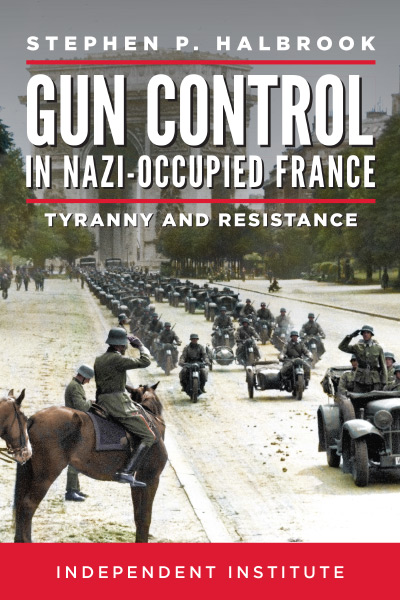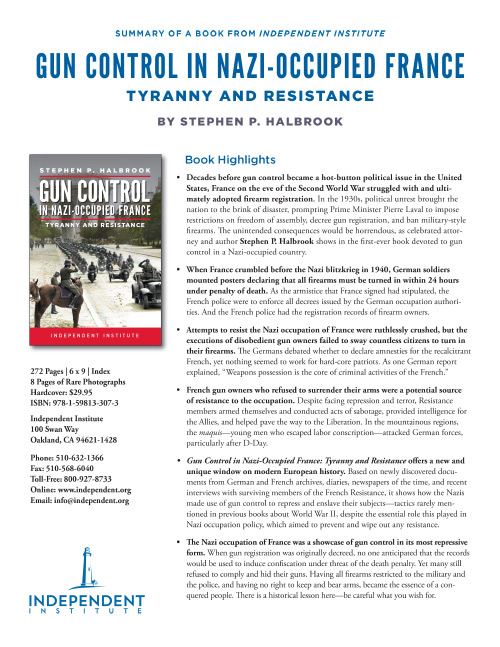Highlights
- Decades before gun control became a hot-button political issue in the United States, France on the eve of the Second World War struggled with and ultimately adopted firearm registration. In the 1930s, political unrest brought the nation to the brink of disaster, prompting Prime Minister Pierre Laval to impose restrictions on freedom of assembly, decree gun registration, and ban military-style firearms. The unintended consequences would be horrendous, as celebrated attorney and author Stephen P. Halbrook shows in the first-ever book devoted to gun control in a Nazi-occupied country.
- When France crumbled before the Nazi blitzkrieg in 1940, German soldiers mounted posters declaring that all firearms must be turned in within 24 hours under penalty of death. As the armistice that France signed had stipulated, the French police were to enforce all decrees issued by the German occupation authorities. And the French police had the registration records of firearm owners.
- Attempts to resist the Nazi occupation of France were ruthlessly crushed, but the executions of disobedient gun owners failed to sway countless citizens to turn in their firearms. The Germans debated whether to declare amnesties for the recalcitrant French, yet nothing seemed to work for hard-core patriots. As one German report explained, “Weapons possession is the core of criminal activities of the French.”
- French gun owners who refused to surrender their arms were a potential source of resistance to the occupation. Despite facing repression and terror, Resistance members armed themselves and conducted acts of sabotage, provided intelligence for the Allies, and helped pave the way to the Liberation. In the mountainous regions, the maquis—young men who escaped labor conscription—attacked German forces, particularly after D-Day.
- Gun Control in Nazi-Occupied France: Tyranny and Resistance offers a new and unique window on modern European history. Based on newly discovered documents from German and French archives, diaries, newspapers of the time, and recent interviews with surviving members of the French Resistance, it shows how the Nazis made use of gun control to repress and enslave their subjects—tactics rarely mentioned in previous books about World War II, despite the essential role this played in Nazi occupation policy, which aimed to prevent and wipe out any resistance.
- The Nazi occupation of France was a showcase of gun control in its most repressive form. When gun registration was originally decreed, no one anticipated that the records would be used to induce confiscation under threat of the death penalty. Yet many still refused to comply and hid their guns. Having all firearms restricted to the military and the police, and having no right to keep and bear arms, became the essence of a conquered people. There is a historical lesson here—be careful what you wish for.
Synopsis
Countless works have been written about the German occupation of France during World War II, but until now no book has focused on the repression of gun owners. With the publication of Gun Control in Nazi-Occupied France: Tyranny and Resistance, author and attorney Stephen P. Halbook (Gun Control in the Third Reich, Securing Civil Rights, The Founders’ Second Amendment) tells a story long waiting to be told. Focusing on the years 1934 through 1945, Halbrook examines France’s political convulsions, its laws restricting free assembly and requiring gun registration, its invasion and occupation by Nazi Germany, repression, execution of gun owners, resistance, and finally liberation. Here at last is the key that unlocks the secret history of France’s occupation under a brutal regime and the developments that helped lay the groundwork.
Drawing on newly discovered documents from German and French archives, diaries, and newspapers of the time, Gun Control in Nazi-Occupied France not only adds immeasurably to our understanding of history, but it also remedies a longstanding injustice: history’s neglect of the men and women who risked the firing squad by defying German-issued decrees to surrender all firearms.
“If nothing else, it is fitting to remember and pay tribute to the French gun owners who resisted as well as those who were executed for defying orders to surrender their revolvers and hunting guns, and who thereby contributed in one way or another to the Resistance,” Halbrook writes. “While not every French citizen caught with a gun was shot, the very real threat of the firing squad was not enough to induce every gun owner to comply, leading the Germans repeatedly to declare amnesties.”
Path to Persecution
A German poster requiring all people to surrender their firearms within 24 hours or face the death penalty is on prominent display in Paris at the Musée de l’Ordre de la Libération (Museum of the Order of Liberation). The burden of enforcing the edict, which was issued in 1940 shortly after the occupation began, fell on the Vichy government and its leading promotor, Pierre Laval.
Years before he became the most notorious collaborator with the German occupiers, Laval as prime minister decreed the registration of firearms in 1935 in response to political strife. Issued following several violent incidents, such as a 1934 massacre in which police and the Mobile Guard opened fire on protesters, gunning down 18 civilians, Laval’s decree also restricted free assembly, increased the size of the Mobile Guard, and banned rifles and pistols considered military-style.
Compliance with the gun registration requirement was problematic, however. A case study of the Ardennes department revealed few registrants. With internal and external threats looming, more gun restrictions were imposed. Gun sales were halted. The press reported searches of houses in which arms were found belonging to persons rumored to be communists. While disarming her citizens, France reacted to Hitler’s growing threat by imposing military conscription and building the Maginot Line.
Invasion and Occupation
Germany’s 1940 blitzkrieg defeated France in a matter of weeks. In every town square, posters were nailed up declaring that persons who failed to turn in their firearms within 24 hours would be subject to the death penalty. The French government reconstituted itself in Vichy and negotiated an armistice in which it agreed to enforce the orders of the German occupation authorities. Among other repressive measures, the French police were now in charge of confiscating firearms, and they had the gun-owner registration records with which to do so.
The Vichy government reconstituted itself along authoritarian lines headed by Philippe Pétain and Pierre Laval, who would become the chief collaborator with Nazi Germany. They took orders from Otto von Stülpnagel, the German military commander headquartered in Paris. While many Frenchmen were turning in their firearms, others were hiding theirs. The Germans reported that cooperation with the French police was high. Periodic reports were issued of illegal weapons possession and other offenses against the occupation, as well as statistics on enormous quantities of arms being confiscated. Surrendered guns were supposed to be returned to their owners when peace came, but instead many were looted by or sold to German soldiers.
Gun Possession, Execution, and Resistance
Germany’s attack on Russia released the French communists from their orders from Moscow under the Hitler-Stalin pact not to oppose the German occupation. The communists began a campaign to assassinate German soldiers, leading Hitler to order the execution of scores of French hostages. From his London exile, Charles de Gaulle warned against such random attacks. A more sustainable Resistance movement was forming, members of which were arming themselves, sabotaging infrastructure essential to the Germans, and providing intelligence to the Allies. Executions of gun owners were prominently announced.
In desperation, the Germans allowed a brief amnesty for the surrender of hunting arms, which supposedly would be tagged and returned after the war. Such measures didn’t work either, so Hitler issued the Night and Fog Decree—persons caught with guns, anti-German leaflets, or other violations would disappear without any trace.
The Germans knew that many French held on to their guns, and thus amnesty continued to be debated, despite the incongruity of having shot so many for gun possession and then letting others turn in their firearms without punishment. The time also came to impose the death penalty on persons who failed to denounce others known to possess a firearm. The French police continued to use the registration records on behalf of the Germans, including to trace firearms used to attack German soldiers. The SS under Karl Oberg took over repressive measures from the German military.
Armed Resistance and Liberation
The Allied invasion of North Africa spurred the Germans to take over the previously unoccupied area of France. A new wave of gun confiscations, repression, and executions pervaded the country. The Vichy government issued its own siren song promising to return surrendered arms but threatening disobedience with death by guillotine. Afraid that Resistance members would break into depots of seized arms, the Germans considered shipping them to Germany but settled on the ruse of returning the barrels to their owners, while keeping the other gun parts so as to render them unusable. The Resistance seized back what it could and begged the Allies to air drop more arms, which were never enough. The SS rejected a new amnesty knowing that those organizing to fight back would never turn in their guns. Both sides were getting ready for the looming Allied invasion.
D-Day was the signal for resistance groups to escalate sabotage of rail and communications, and to launch armed attacks on German forces, which hit back at the French guerillas in the mountains and committed atrocities against the general population. In Paris, insurgents mounted the barricades and fought the Wehrmacht in the streets until Allied forces arrived, liberating the city. With most of France liberated, the time came for a reckoning. It was estimated that only a third of the hunting guns had been surrendered, a testament to massive disobedience to draconian gun control. Trials were held of traitors who denounced fellow citizens for anti-German offenses, including not turning in guns. The Vichy collaborators were brought to justice, most prominently Pierre Laval, who was shot at the same prison where his Nazi partners had executed countless citizens.
Repression in Retrospect
When Laval decreed gun registration in 1935, no one anticipated that five years later France would be overrun by and become a vassal state of Nazi Germany. Gun owners would join the ranks of others in all walks of life who would be subject to ruthless repression for failure to obey the occupation diktats. Many not caught and executed hid their firearms and waited until the time came to strike back. Just as the French army couldn’t protect the country in 1940, the armed citizens who made up the Resistance could not overthrow the Nazi tyranny without the Allied invasion, but they contributed greatly to the Liberation. France’s nightmare in that era had many elements, but it suggests a telling lesson: history does not always repeat itself, but rue the day when it does.








